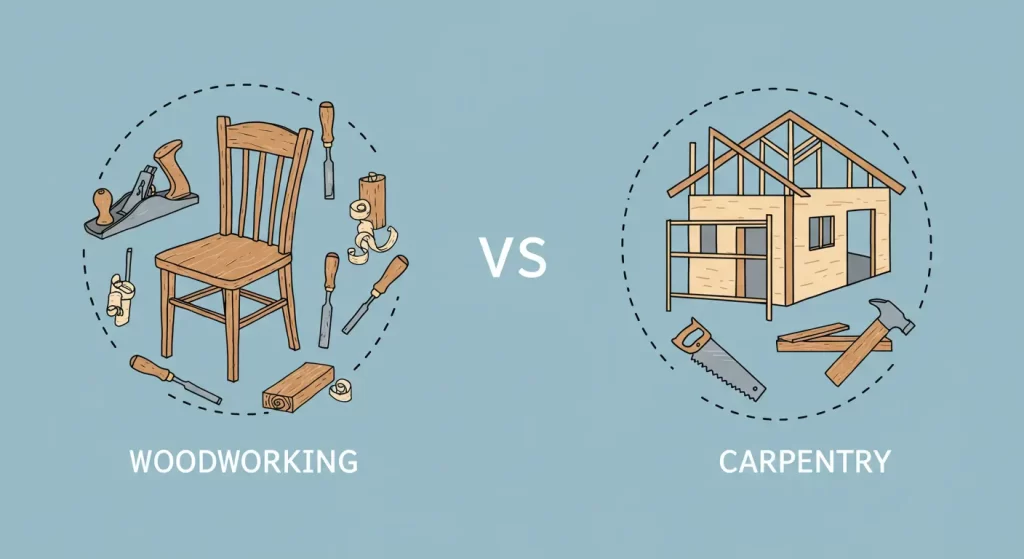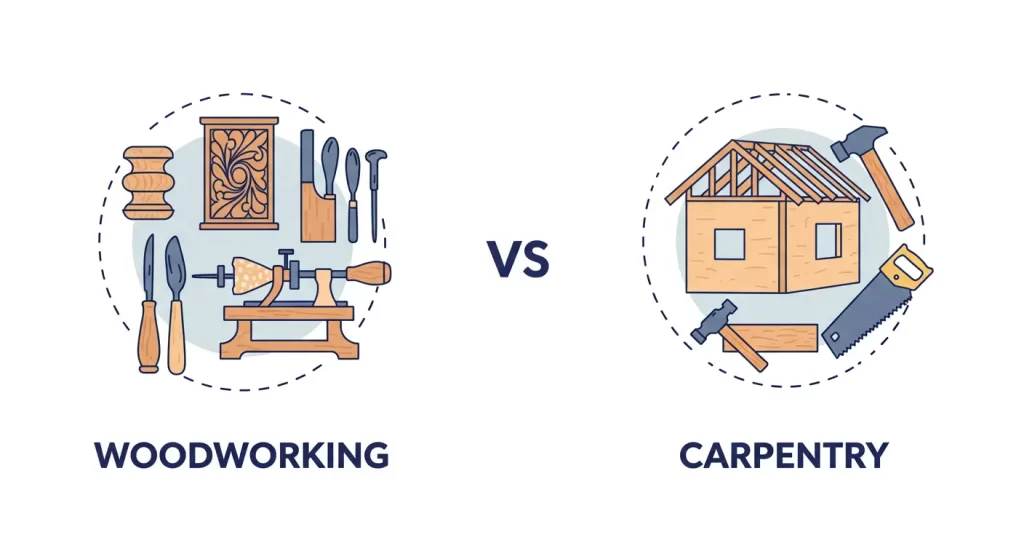
If you’ve ever browsed Pinterest for DIY projects or binge-watched home renovation shows, you’ve probably heard the terms woodworking and carpentry tossed around. At first glance, they seem interchangeable—both involve wood, tools, and creating something from scratch. But here’s the thing: they’re not the same. Understanding the distinction isn’t just semantics—it can help you choose the right tools, plan projects, or even pivot careers. Let’s break it down.
So, What Is Woodworking?
Woodworking is the art and craft of creating objects from wood. Think of it as the “fine arts” branch of working with timber. Woodworkers are the folks who hand-carve intricate furniture, turn bowls on a lathe, or craft decorative wall art. Their work often prioritizes aesthetics, precision, and creativity.
For example, a woodworker might spend weeks perfecting a dovetail joint on a custom walnut desk or sculpting a live-edge coffee table. They’re detail-obsessed, working with hardwoods like oak, cherry, or mahogany, and often use specialized tools like chisels, planes, and carving knives. According to The Wood Database, woodworking emphasizes “the transformation of raw wood into functional or artistic pieces through techniques like joinery, carving, and finishing.”
Key traits of woodworking:
- Focus: Artistic expression, craftsmanship, and detail.
- Common projects: Furniture, cabinetry, musical instruments, sculptures.
- Tools: Chisels, lathes, hand planes, routers.
And What About Carpentry?
Carpentry, on the other hand, is the trade of cutting, shaping, and installing building materials. It’s more about structural work and practicality. Carpenters are the backbone of construction—they frame houses, install doors and windows, build roofs, and repair decks. While they also work with wood, their materials often include engineered lumber, plywood, and even metal or concrete.
As Family Handyman puts it, carpentry is “the art of turning architectural plans into physical structures.” Speed and efficiency matter here, since carpenters often work on tight deadlines. You’ll see them wielding power tools like circular saws, nail guns, and laser levels.
Key traits of carpentry:
- Focus: Functionality, structural integrity, and construction.
- Common projects: Framing, roofing, installing cabinetry, building staircases.
- Tools: Power drills, framing hammers, miter saws, levels.
The Big Difference: Art vs. Trade

The simplest way to differentiate the two? Woodworking is an art; carpentry is a trade.
- Woodworking thrives on creativity. It’s about pushing boundaries—like using epoxy resin to highlight natural wood grain or designing a chair that’s equal parts comfort and sculpture.
- Carpentry is rooted in practicality. It’s ensuring a roof doesn’t leak, a floor is level, or a staircase meets safety codes.
That said, there’s plenty of overlap. Many carpenters dabble in woodworking (e.g., crafting custom shelves), and woodworkers occasionally tackle structural projects (like building a workshop). But their core priorities differ.
Side-by-Side Comparison
To make things crystal clear, here’s a quick breakdown:
Woodworking vs. Carpentry
Comparison of Woodworking and Carpentry
| Aspect | Woodworking | Carpentry |
|---|---|---|
| Primary Focus | Aesthetic, artistic creation | Structural, functional construction |
| Materials Used | Hardwoods (oak, walnut), veneers | Softwoods (pine), plywood, engineered lumber |
| Tools | Hand tools, lathes, carving knives | Power tools, nail guns, circular saws |
| End Products | Furniture, art pieces, intricate boxes | Houses, decks, installed cabinetry |
| Skill Emphasis | Precision, design, finishing techniques | Speed, measurements, building codes |

When Worlds Collide: The Gray Area
Despite their differences, woodworking and carpentry often intersect. For instance:
- Custom Carpentry: A carpenter building built-in bookshelves might use woodworking techniques for a polished finish.
- DIY Overlaps: Homeowners tackling a patio table project might blend carpentry (building the base) with woodworking (sanding and staining the top).
- Historic Restoration: Restoring a 19th-century cabinet requires both carpentry (repairing structural damage) and woodworking (matching antique finishes).
As The Spruce Crafts notes, hybrid projects are becoming more common as DIYers and pros alike experiment with blending form and function.
Why This Matters for You
Understanding the distinction isn’t just academic—it has real-world implications:
- Choosing a Career Path
- Love creating heirloom furniture? Pursue woodworking.
- Prefer building homes or working on construction sites? Carpentry’s your lane.
2. Selecting Tools
- Woodworkers invest in hand planes, clamps, and finishing supplies.
- Carpenters prioritize power tools like impact drivers and reciprocating saws.
3. Planning Projects
- Building a gazebo? You’ll need carpentry skills for the frame and woodworking skills for the benches.
- Crafting a jewelry box? Focus on woodworking techniques like dovetailing and sanding.
4. Budgeting
- Hardwoods (common in woodworking) are pricier than the softwoods carpenters typically use.
The Tools Tell the Story

Peek into a woodworker’s shop, and you’ll see hand tools designed for precision:
- Chisels for carving fine details.
- Hand planes to smooth surfaces.
- Dovetail jigs for flawless joints.
A carpenter’s toolbox, meanwhile, is all about efficiency:
- Nail guns for rapid fastening.
- Speed squares to mark angles quickly.
- Laser levels to ensure perfect alignment.
As Wood Magazine explains, “Woodworkers measure twice and cut once; carpenters measure once and cut twice—because time is money.”
Materials Matter, Too
Woodworkers often splurge on exotic hardwoods like cherry or mahogany for their durability and beauty. These woods are denser, harder to work with, and costlier—but the results are stunning.
Carpenters, meanwhile, rely on softer, cheaper woods like pine or fir, which are easier to cut and ideal for structural work. They also use engineered products like OSB (oriented strand board) for sheathing walls or I-joists for floor framing.
Which One Should You Try?
Still unsure where to start? Ask yourself:
- Do I enjoy slow, meditative projects? Try woodworking.
- Do I prefer seeing quick, tangible results? Carpentry might suit you.
For beginners, carpentry can feel more accessible—basic skills like measuring and using a power saw are easier to pick up. Woodworking requires patience to master techniques like hand-cut joinery or French polishing.
Final Thoughts: Two Sides of the Same Coin
At the end of the day, both woodworking and carpentry celebrate the versatility of wood. One focuses on beauty, the other on strength—but together, they shape the spaces we live in and the objects we cherish.
Whether you’re building a birdhouse or a banquet table, remember: Every cut tells a story. So grab a saw (or a chisel), and start creating! And if you’re hungry for more, check out these resources:
Happy building! 🛠️